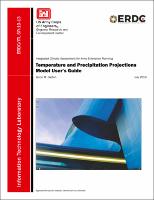Please use this identifier to cite or link to this item:
https://hdl.handle.net/11681/33606Full metadata record
| DC Field | Value | Language |
|---|---|---|
| dc.contributor.author | Garton, Byron M. | en_US |
| dc.creator | Information Technology Laboratory (U.S.) | en_US |
| dc.date.accessioned | 2019-07-31T13:14:07Z | en_US |
| dc.date.available | 2019-07-31T13:14:07Z | en_US |
| dc.date.issued | 2019-07 | en_US |
| dc.identifier.govdoc | ERDC/ITL SR-19-13 | en_US |
| dc.identifier.uri | https://hdl.handle.net/11681/33606 | en_US |
| dc.identifier.uri | http://dx.doi.org/10.21079/11681/33606 | en_US |
| dc.description | Special Report | en_US |
| dc.description.abstract | The potential effects of climate change on temperature and precipitation at Department of Defense (DoD) installations are far ranging, and understanding their impacts is essential to maintaining optimal force stationing and readiness. This model attempts to predict changes in daily and monthly average temperature and precipitation for several scenarios from future climate projections for various DoD installations. This document describes the process of executing the Temperature and Precipitation Projections Model, as it exists at the time of this publication, within the common computational environment established under the software integration effort of the Integrated Climate Assessment for Army Enterprise Planning work package. | en_US |
| dc.description.sponsorship | Integrated Climate Assessment for Army Enterprise Planning Program (U.S.) | en_US |
| dc.description.tableofcontents | Abstract .................................................................................................................................... ii Figures...................................................................................................................................... iv Preface ...................................................................................................................................... v 1 Introduction ...................................................................................................................... 1 1.1 Background ........................................................................................................ 1 1.2 Objective ............................................................................................................ 1 1.3 Requirements .................................................................................................... 2 2 Viewing Computed Data .................................................................................................. 3 3 Building New Data ........................................................................................................... 8 4 Known Issues and Limitations ..................................................................................... 13 5 Additional Help ............................................................................................................... 14 Reference ............................................................................................................................... 15 Appendix A: Acronyms and Abbreviations ......................................................................... 16 Report Documentation Page | en_US |
| dc.format.extent | 25 pages / 1.818 Mb | en_US |
| dc.format.medium | en_US | |
| dc.language.iso | en_US | en_US |
| dc.publisher | Engineer Research and Development Center (U.S.) | en_US |
| dc.relation.ispartofseries | Special Report (Engineer Research and Development Center (U.S.)) ; no. ERDC/ITL SR-19-13 | en_US |
| dc.rights | Approved for Public Release; Distribution is Unlimited | en_US |
| dc.source | This Digital Resource was created in Microsoft Word and Adobe Acrobat | en_US |
| dc.subject | Military bases | en_US |
| dc.subject | Meteorology | en_US |
| dc.subject | Temperature | en_US |
| dc.subject | Precipitation (Meteorology) | en_US |
| dc.subject | Climatic changes--Risk assessment | en_US |
| dc.title | Temperature and Precipitation Projections Model user’s guide | en_US |
| dc.type | Report | en_US |
| Appears in Collections: | Special Report | |
Files in This Item:
| File | Description | Size | Format | |
|---|---|---|---|---|
| ERDC-ITL SR-19-13.pdf | ERDC/ITL SR-19-13 | 1.86 MB | Adobe PDF |  View/Open |